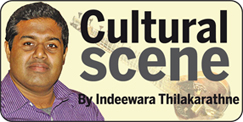Balangoda as an anthropological hot spot : have we missed an
opportunity?
 In the broadest sense, anthropology is the study of human cultural
diversity deals with various aspects of humanity. Anthropology remains
dedicated to studying the diversity of human expression through space
and time focusing on'Homosapiens and the evolution of the physical and
cultural traits of Homo sapiens. However, the importance of anthropology
lies not only in the discovery of physical evolution of modern human
beings and their specific behaviours but also the evolution of culture
in a given geographical area. In the broadest sense, anthropology is the study of human cultural
diversity deals with various aspects of humanity. Anthropology remains
dedicated to studying the diversity of human expression through space
and time focusing on'Homosapiens and the evolution of the physical and
cultural traits of Homo sapiens. However, the importance of anthropology
lies not only in the discovery of physical evolution of modern human
beings and their specific behaviours but also the evolution of culture
in a given geographical area.
Anthropology has a discipline is divided into four main sub-fields
such as 'Social Anthropology', 'Archaeology', 'Linguistic Anthropology'
and ' Biological/ physical anthropology'. Similar to many fields of
studies in social sciences and humanities such as cultural studies,
literature and communication, during the 1970-1980s, sub-fields of
anthropology emerged under the overarching influence of post modern
thinking and post modern ideas, making an epistemological shift of the
subject from its original positivist tradition which is by and largely
responsible for formation of the discipline.
One of the central issues during this shift was the questions raised
on the nature of generating knowledge particularly in the sub-fields of
Cultural and Social Anthropology. However, the other sub-fields of
anthropology, namely, Archaeology, Biological Anthropology and
Linguistic Anthropology, by and large, remain positivistic in their
research perspectives.
The origin and evolution of modern Cultural anthropology
The origin and evolution of modern Cultural anthropology can be
traced back to the development of ethnology in 19th century. The earlier
cultural anthropologist such as E.B Tylor and J.G Frazer worked with
material gathered by others; missionaries, explorers or colonial
officers. However, 20th-century anthropologists largely reject the
notion that all human societies must undergo same process in an
identical order which cannot be proved beyond doubt with empirical
evidences.
Although 19th century occupied major arguments among the ethnologists
in theories of 'diffusion' and 'independent inventions' as mutually
exclusive and competing theories, some argued that both processes can
occur and can account for cross-cultural similarities. However, the
focus of socio-cultural anthropologist in the early 20th century in
Europe shifted from these dogmatic issues to observing social behaviours
and on social culture. In other words, observing on relationships among
social roles such as husband and wife and parents and children.
American Cultural Anthropologist focused on the ways in which people
expressed their view of themselves and the world at large. Particular
emphasis was on symbolic forms such as art and myth. However, these two
approaches are often converged and useful as effective research tools.
Importance of Balangoda an anthropological research lab
Although Balangoda may be famous for the pre-historic man, Homo
Balangodasia who was similar to other pre-historic human species such as
Java man, present day importance of Balangoda rests in Social and
Cultural Anthropology rather than in Archaeology and Physical
Anthropology.
It is pertinent, albeit briefly, to look into the evolution of
Cultural Anthropology in order to understand the importance of Balangoda
as an Anthropological hot spot. Primarily Cultural Anthropology examines
culture as a scientific discipline. The focus of the study is on the
impact of global economic and political processes on local cultural
realities. Among the diverse methods that anthropologists employ include
participant observation, interviews and surveys. Such anthropological
research is often called fieldwork as it involves considerable time in
an around the chosen field site or study area.
A significant aspect of Balangoda as a cultural hot spot is that it
has relatively not been affected by the globalisation and political
process on local cultural realities. For instance, 'Uggal Aluth Nuwara
Devalaya' ( an ancient shrine dedicated to the God Muruga or God
Kataragama) located in Imbulpe has preserved its traditional procession
in their original form despite the collapsed of social order and the
influence of global economy on the population. The work order of
maintaining and conducting religious rites at the Devalaya and temple is
carried out by people from generation to generation by genealogy.
Opportunity
The annual procession of the temple has not been highly publicised
unlike the temple of the tooth relict or Dalada Maligawa. Among other
things the area is extremely rich in folklores and legends often
associated with the formation of village names and places of interest.
However, what is surprising is that there is no Department of
Anthropology at the University of Sabaragamuwa although it is situated
right in the heart of an anthropological treasure stove.
We presume the policy makers and those who will take the
responsibility in the new Cabinet for higher education will explore the
possibility of establishing a Department of Anthropology at the
University of Sabaragamuwa Sabaragamuwa |

